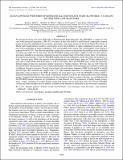SLOAN LOW-MASS WIDE PAIRS OF KINEMATICALLY EQUIVALENT STARS (SLoWPoKES): A CATALOG OF VERY WIDE, LOW-MASS PAIRS
Author(s)
Dhital, Saurav; Stassun, Keivan G.; Bochanski, John J.; West, A. A.
DownloadDhital-2010-SLOAN LOW-MASS WIDE.pdf (2.827Mb)
PUBLISHER_POLICY
Publisher Policy
Article is made available in accordance with the publisher's policy and may be subject to US copyright law. Please refer to the publisher's site for terms of use.
Terms of use
Metadata
Show full item recordAbstract
We present the Sloan Low-mass Wide Pairs of Kinematically Equivalent Stars (SLoWPoKES), a catalog of 1342 very-wide (projected separation [> over ~] 500 AU), low-mass (at least one mid-K to mid-M dwarf component) common proper motion pairs identified from astrometry, photometry, and proper motions in the Sloan Digital Sky Survey. A Monte Carlo-based Galactic model is constructed to assess the probability of chance alignment for each pair; only pairs with a probability of chance alignment ≤0.05 are included in the catalog. The overall fidelity of the catalog is expected to be 98.35%. The selection algorithm is purposely exclusive to ensure that the resulting catalog is efficient for follow-up studies of low-mass pairs. The SLoWPoKES catalog is the largest sample of wide, low-mass pairs to date and is intended as an ongoing community resource for detailed study of bona fide systems. Here, we summarize the general characteristics of the SLoWPoKES sample and present preliminary results describing the properties of wide, low-mass pairs. While the majority of the identified pairs are disk dwarfs, there are 70 halo subdwarf (SD) pairs and 21 white dwarf-disk dwarf pairs, as well as four triples. Most SLoWPoKES pairs violate the previously defined empirical limits for maximum angular separation or binding energies. However, they are well within the theoretical limits and should prove very useful in putting firm constraints on the maximum size of binary systems and on different formation scenarios. We find a lower limit to the wide binary frequency (WBF) for the mid-K to mid-M spectral types that constitute our sample to be 1.1%. This frequency decreases as a function of Galactic height, indicating a time evolution of the WBF. In addition, the semi-major axes of the SLoWPoKES systems exhibit a distinctly bimodal distribution, with a break at separations around 0.1 pc that is also manifested in the system binding energy. Compared with theoretical predictions for the disruption of binary systems with time, we conclude that the SLoWPoKES sample comprises two populations of wide binaries: an "old" population of tightly bound systems, and a "young" population of weakly bound systems that will not survive more than a few Gyr. The SLoWPoKES catalog and future ancillary data are publicly available on the Internet for utilization by the astronomy community.
Date issued
2010-05Department
MIT Kavli Institute for Astrophysics and Space ResearchJournal
Astronomical Journal
Publisher
IOP Publishing
Citation
Dhital, Saurav, Andrew A. West, Keivan G. Stassun, and John J. Bochanski. “SLOAN LOW-MASS WIDE PAIRS OF KINEMATICALLY EQUIVALENT STARS (SLoWPoKES): A CATALOG OF VERY WIDE, LOW-MASS PAIRS.” The Astronomical Journal 139, no. 6 (May 7, 2010): 2566–2586.
Version: Final published version
ISSN
0004-6256
1538-3881